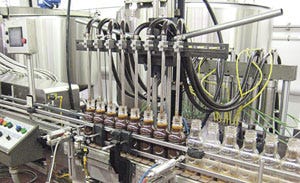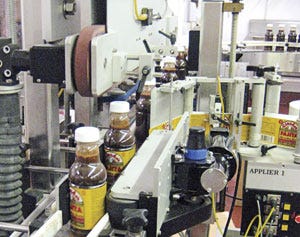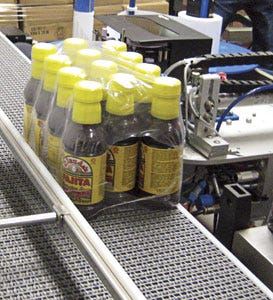Switching from glass to PET slashes freight costs for Claude's Sauces
|
Liquid components are filled on an intermittent-motion, in-line filler that fills eight bottles at a time. |
Switching from glass to a PET bottle and the installation of a new packaging line is paying big dividends for Claude's Sauces, Inc., El Paso, TX. “Conversion from glass to PET has resulted in 50 percent reduction in freight costs and a 90 percent reduction in breakage/damaged goods charge-backs from retailers,” says owner Joe Castanada. “Additionally, due to the standardization to 16-oz from a mix of 12- and 16-oz bottles, production changeover time has gone from four or five hours, down to less than one.”
Claude's Sauces, Inc. got started with a mouth-watering brisket marinade developed from an old German recipe more than three decades ago. From that humble beginning, the company now produces a range of Tex-Mex products including seasonings and refried bean products. Owner Joe Castanada takes pride in his unique formulations. He points out that even though Claude's Sauces is a small company, its goal is to “try and keep up with the big boys.” With that goal, Claude's recently installed a new packaging line and switched to a new PET bottle.
|
The packaging line starts with a Model AU6 Orientainer® unscrambler from Kaps-All Packaging Systems (www.kapsall.com). Bottles are randomly dumped into the supply hopper, from which they are deposited into the rotary prefeeder bowl on demand. As the prefeeder turns, the containers are single filed and sent down an adjustable slide chute, where they enter a stand-up unit that orients them in an upright position.
The 16-oz, long-neck PowerFlex™ PET bottles from Amcor PET Packaging (www.amcor.com) are conveyed past an accumulation table that provides storage in case of a momentary down-stream stoppage and then enter a Kaps-All Clean-N-Vac bottle cleaner. This machine turns the bottles upside-down and blasts high-pressure, ionized air into the bottles. The ionization neutralizes static electricity, which frees dust and dirt, which is removed by a vacuum system.
Dry and liquid filling
The bottles than travel to a Model 400 intermittent-motion auger filler from AMS Filling Systems, Inc. (www.amsfilling.com) that dispenses dry spices into the bottles. The filler is equipped with an Allen-Bradley PLC and an operator panel from Rockwell Automation (www.rockwell.com). The operator sets the number of auger revolutions required to dispense the proper amount of spice for each product, and this data is stored in memory and can be recalled as needed. Bottles are held back at the inlet of the unit, and are admitted to the filling zone one at a time. A signal triggers the operation of the auger when the bottle is in place, and it revolves the required number of times. Spices are delivered to the overhead hopper of the filler from a floor hopper by a screw conveyor that is turned on and off by level switches in the filler hopper.
|
A labeling system applies wraparound UV-coated paper labels to the bottles, above. The labeling system is equipped with two stepper-driven label applicators. The bottles then travel to a tamper-evident bander that applies neck bands that go over the edges of the caps and extend down to the shoulders of the longneck bottles. |
|
Next the bottles are conveyed to a Model AESFillAF12 intermittent-motion, inline filler from Aesus Packaging Systems (www.aesus.com). The filler can run up to 12 bottles at a time, but during this operation, it was running only eight. At the beginning of each cycle, a gate at the entrance opens to admit the bottles, while a gate at the exit closes to hold them in place beneath the nozzles.
When the bottles are in place, the nozzles, which are equipped with spring-loaded collars, descend and the collars seal against the tops of the bottles. Spring-loaded valves in the nozzles open so product can flow. In this timed, pressure filler, product is pumped from a hold tank by a diaphragm pump to all of the bottles simultaneously through separate hoses. When each bottle is full, excess product flows through a hose back to the product holding tank. For each product, the time that the pump operates is set by the operator to ensure that no bottle is underfilled. When this time elapses, the pump shuts off. At this point, the valves in the nozzles close, the nozzles rise, and the gates open to allow the filled bottles to leave and the next group of empty bottles to enter. A PLC and control panel include memory capabilities so that line speed and fill-volume control can be entered and recalled for all products that will be run.
The filled bottles travel to a Kaps-All Model A6 six-spindle capper. An overhead rotary cap feeder orients the caps open-side-down and delivers them down a track to the capping head, where the bottles pick the caps from the track discharge as they enter the torquing section of the machine. The capper features a remote-controlled clutch system. Pneumatically operated torque-limiting clutches allow the operator to adjust the application torque of the caps as they are applied to the containers. They can be adjusted while the machine is in operation, eliminating lost time and the need to adjust each clutch individually. Calibrated dials assure the operator of repeatable torque setting for each capping application without the need of torque wrenches and separate tools.
The capper incorporates an electronic torque monitor that measures the application torque of the caps while they are being applied to the container and signals the operator if the torque is out of spec. The torque is displayed on a liquid-crystal display screen, and a built-in computer with a standard statistical analysis package allows an operator to display the test results.
Wraparound labeling
After the capper, the bottles are conveyed through a Model AM-20 induction sealer from AutoMate Technologies, LLC (www.automatetech.com). The user-friendly unit features a digital control panel that allows the operator to easily set up and diagnose the sealer for quick changeovers.
|
Bundles leaving the wrapper travel past a print-and-apply labeler that applies shipping labels. |
The bottles then pass beneath the printhead of a Model 4900 ink-jet printer from Diagraph, an ITW co. (www.diagraph.com), that applies the lot number and sell-by date to the top of the cap. This small-character, continuous printer can store in its memory data for up to 50 items and other running parameters that the operator can easily recall.
Labels are then applied by a Model CP2000 pressure-sensitive labeler from Universal Labeling Systems, Inc. (www.universal1.com) that can apply front, back and wraparound labels. It is also equipped with a print and apply unit that includes a Model 408 thermal-transfer printer from Sato America, Inc. (www.satoamerica.com). Claude's runs wrap-around UV-coated paper labels, which are supplied by Reliant Labels & Printing (915/544-8884), to its plastic sauce and marinade bottles. The labeling system is equipped with two of Universal's SL2000 stepper-driven label applicators and features photoelectric label and bottle sensors. The labeling system incorporates Universal's automatic speed-following system and synchronous overhead bottle hold-down system and product positioning in which all of the system's operations change synchronously when an operator changes an operating parameter, such as line speed.
The bottles then travel to a Model EZ-100HSX tamper-evident bander from Axon Corp. (www.axoncorp.com) that applies neck bands that go over the edges of the caps and extend down to the shoulders of the long-neck bottles. Film is pulled from a roll mounted on the back of the machine and is pulled over the top of the machine and down through the machine by opposing stepper-driven rollers. The flat film is reoriented by a “bullet” or mandrel, after which a guillotine blade cuts it to the proper length.
Grippers with suction cups then open the film, A photo eye senses the movement of the bottle and synchronizes the application of the film via a pneumatic plunger. Bottles leaving the bander travel through a hot-air tunnel that shrinks the band onto the bottle.
Unsupported bottle wraps
Next the bottles enter a Model 230-60 side-feed shrink bundler from Tekkra Systems, Inc. (www.tekkra.com) that produces six, 12 and 24 packs of unsupported bottles. The machine wraps each package configuration in a bull-eye style closure. As the bottles enter the machine, oscillating lane guides distribute them into multiple lanes—two lanes for six packs, three lanes for 12 packs and four lanes for 24 packs.
At the start of each wrap cycle, a clamp holding back the bottles in the lanes opens and releases the bottles. When the correct number of rows of bottles (e.g., three rows for a six pack) has been released, a sensor activates the clamp to hold back the bottles in the lanes until the next cycle. A sensor then triggers a servo-driven pusher assembly that comes in from the side and pushes the bottles through the web of film.
Two rolls of LLDPE film are mounted above and below the machine respectively. The film enters the machine parallel to the direction of bottle travel. Each layer of film passes over a series of dancer bars that maintain tension and control. The two layers are joined by seal bars; one cold bar from below and one hot bar from above, that meet in the center of the servo-seal frame assembly.
The servo-driven pusher pushes the bottles through the film curtain, and the seal bars come together after the product passes through the wrapping zone to form the sleeve around the bundle. Knife blades in the hot bar cut the film to separate that bundle and to establish the film curtain for the next bundle. The bottles then enter the shrink tunnel, which tightly shrinks the film around the bottles.
Bundles leaving the wrapper travel past a Diagraph Model PA/4600 print and apply labeler that is equipped with a Sato 408 print engine that applies shipping labels to the bundles. In this operation, a photo eye senses when a bundle is present and triggers the label printing and application. A computer in the unit stores the label details for each product.
“My retailers and distributors reacted very favorably to the new bottles. We were very happy to finally find a bottle that would meet all of our requirements,” Castanada explains. The dramatic cost savings associated with the conversion also benefited consumers. The company was able to increase several of the SKUs from 12 to 16 oz and not raise the retail selling price. “Our customers got a heck of a deal,” Castanada says. Production was also dramatically affected. “Instead of being down four or five hours to make a glass change, all we need to do now is sanitize, and change the sauce, labels and coders. The whole process takes about an hour,” he says.
More information is available: |
Amcor PET Packaging-North America, 734/302-2272. www.amcor.com. |
Aesus Packaging Systems, 514/697-0053. www.aesus.com. |
AMS Filling Systems, Inc., 610/942-4200. www.amsfilling.com. |
AutoMate Technologies, LLC, 631/727-8886. www.automatetech.com. |
Axon LLC, 919/772-8383. www.axoncorp.com. |
Diagraph, an ITW co., 636/300-2000. www.diagraph.com. |
Kaps-All Packaging Systems, 631/727-0300. www.kapsall.com. |
Reliant Labels & Printing, 915/544-8884. |
Rockwell Automation, 414/382-2000. www.rockwellautomation.com. |
Sato America, Inc., 704/644-1650. www.satoamerica.com. |
Tekkra Systems, Inc., 630/226-1550. www.tekkra.com. |
Universal Labeling Systems, Inc., 727/327-2123. www.universal1.com. |
About the Author(s)
You May Also Like







